

An archaeologist named Domenico Golini discovered this necropolis in 1863 on a hillside at Settecamini, about 3 km south of the Abbazia dei SS Severo e Martirio on the road to Porano. The tombs, which were laid out in tiers on the hillside, belonged to a number of aristocratic families that had probably had country estates nearby.
Two of the tombs that were on the higher part of the hillside were distinguished by a series of frescoes painted on their walls. These were the first painted tombs that had been discovered in the area and became very widely known. They are referred to as:
-
✴Golini I (dei Leinie); and
-
✴Golini II (dei Verenas).
[Another painted tomb, which belonged to the Hescanus family, was discovered at Castel Rubello, outside Porano, in 1883.]
This page describes the grave goods and frescoes from the necropolis that are exhibited in the Museo Archeologico Nazionale.
Grave Goods (4th century BC)
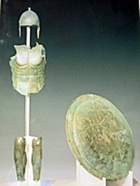
[Anfora from Golini I; stamnos by the Pittore di Settecamini]
[Were these discovered in 1863 or subsequently?]
Frescoes of Golini I and Golini II
When George Dennis visited the site in the 1870s (pp 48-61), the frescoes in the Golini tombs were already deteriorating because of damp. They were detached in 1950 and moved to the Museo Archeologico, Florence. They were transferred to the Museo Archeologico, Orvieto in 1982 and are now displayed in a space that has been designed to replicate the original tombs.
The frescoes are now badly deteriorated, despite a recent restoration. The illustrations below are from copies made at the time. These include a number of preparatory drawings and water colour copies (ca. 1880) by Adolfo Cozza. [Are these water colours still in the Museo Archeologico, Orvieto, or have they been moved to Porano?]
Golini I (4th century BC)
A room in the museum reproduces the arrangement of the older of the two painted tombs, which was divided by a wall of rock into two interconnected spaces:
-
✴the frescoes in the space on the right depict scenes from a banquet in the underworld attended by members of the Leinies family; while
-
✴those in the space on the left depict scenes from its preparation.
Banquet
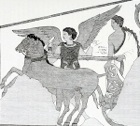
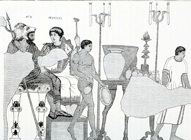
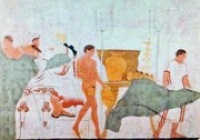
Larth finds a feast in progress, presided over by ‘Eita’ (Hades), who wears a wolfskin on his head, and ‘Phersipnal’ (Persephone). To the right of the royal couple stands a naked slave, followed by a young man in a light, sleeved chiton is identified by the inscription as Vel, Larth’s brother, who had died when aged only seven.
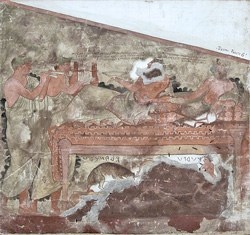
Other members of Larth’s family recline in pairs on four couches. Unfortunately, the frescoes of three of these pairs, one of which was a married couple, have deteriorated. However, pride of place is given to the fourth pair, two men who are drinking to the accompaniment of two musicians. Beneath the couch can be seen servant [inscription] and a hunting leopard identified as Krankru. The two men are identified by inscription (below) as:
Arnth Leinies, his father; and
Vel lecates, his father’s brother.
The inscriptions desribe the high points of their respective careers in public life. Each is described as “son of Larth, grandson of Vel”. In other words, we have the names of six men or boys from four generations of the Leines family, at least four of whom, from two generations, were buried in the tomb.
The inscriptions, which throw some light on the forms of magistracy used in Volsinii in the 4th century BC, are discussed in the page Early Etruscan Inscriptions.
Preparations for the Banquet
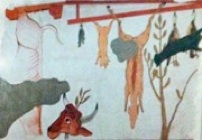

The frescoes in this space show a number of slaves, mostly identified by inscription, who undertake the preparations for the feast. One wonders whether some or all of these were dead by the time that the frescoes were painted, and believed to be in the service of the dead members of the family. The scenes start with a number of butchered carcasses hang from hooks. In the following scenes (not illustrated), a slave butchers another carcass; and fruit is washed and laid out on a table. The lady on the left in the photograph to the right is supervising this last operation. The musician beyond her is playing pipes to provide a beat for another slave who is pounding something in a large mortar. On the next wall, slaves (one of which is visible in the photograph) are cooking in a large oven, while others beyond them continue with preparations for the feast.
Golini II (late 4th century BC)
The room on the right of the one described above reproduces the so-called “Tomba delle Due Bighe” (tomb of the two chariots, which is named for the chariots that were depicted on each side of the entrance). The other walls depicted scenes from a feast in the underworld. These frescoes are in a very poor state of preservation and are largely illegible. The inscriptions refer to two families: Cnezus on the left; and Vercnas on the right.

